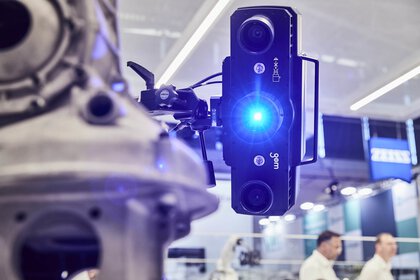Machine vision—the enabler technology
Smart vision systems enable Industry 4.0 and AI applications
Whereas machine vision (MV) is traditionally used to perform conventional inspection tasks, it is now becoming an increasingly important part of production control, too. Virtual commissioning, digital integration, artificial intelligence – attend automatica to experience how vision systems pave the way for digital progress.
Great prospects for both the industry and its customers
Conventional machine vision systems will of course continue to play an important role in industrial applications. They read various kinds of codes, lettering, and markings, which makes them an essential part of material and production flow control. They identify components to be assembled, ensure transparency in the warehouse, perform quality checks of all products as part of ‘end of line’ systems, detect irregularities, and sort products into good and rejected parts.

At the same time, machine vision is becoming an increasingly powerful enabler technology for digital integration. Those looking to exploit the advantages of digital engineering and virtual commissioning need the latest 3D machine vision systems capable of matching the virtual environment with reality via suitable interfaces and communication standards.
Artificial intelligence on the rise
Other trends to be showcased at the trade fair include miniaturization and the integration of cameras and smart evaluation systems to create embedded vision systems. Another technology is just starting out: the combination of machine vision and artificial intelligence. It enables test equipment to independently detect defective parts. Augmented reality systems are another exciting development where camera images can be overlaid with content such as manuals or repair instructions.
And machine vision is opening up more and more fields of application outside of production facilities. Whether online or retail, on the highway, at the doctor's, or on the playing field: their versatility is practically boundless.

Machine vision and its individual product categories
- Machine vision systems as Application-specific or configurable machine vision systems, intelligent cameras, embedded vision systems, vision sensors
- Components for machine vision as optics and illuminations, laser, image sensors, optical sensors, cameras, high speed cameras, infrared cameras, matrix cameras, line scan cameras, X-ray cameras, hyperspectral cameras, frame grabbers, measuring systems, processors and computer components, software or other components for machine vision
- Specific fields of application as robot vision, 2D and 3D measurement and comparison, security systems, recognition of shapes and positions, identification systems and components, surface inspection and texture analysis, X-ray inspection, completeness check, color inspection, quality inspection, optical code reading for 1D codes/barcodes and 2D codes, optical character recognition (OCR), sequence analysis, print inspection
- Augmented reality systems
Exciting parallel event
Laser – World of Photonics is held simultaneously with automatica for the first time this year. Both trade fairs cover optical technology. This expanded offering creates significant synergy effects – particularly from a machine vision point of view.
Well informed: Machine Vision Pavilion
Use the Machine Vision Pavilion as a stage for your trade fair presentation.
Community newsletter subscription
what's up by automatica informs you about everything that occupies, excites and inspires the industry: from exciting insights and innovative applications to relevant market trends.
